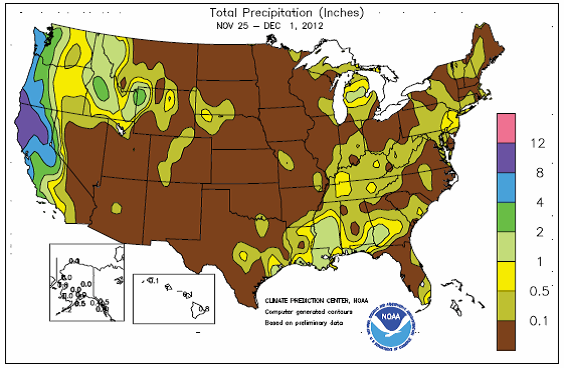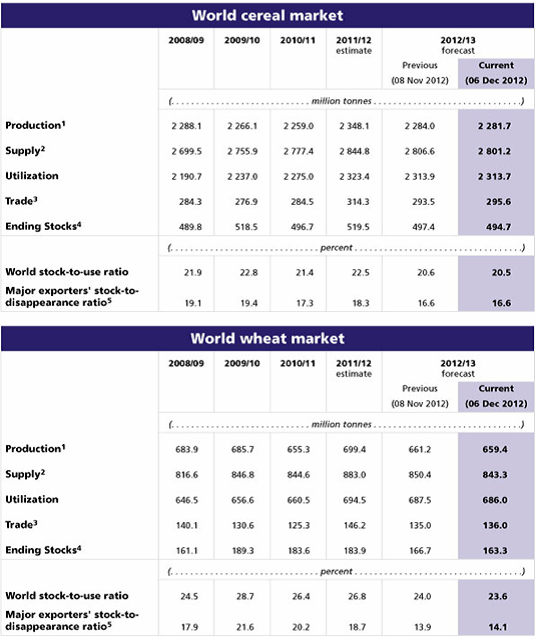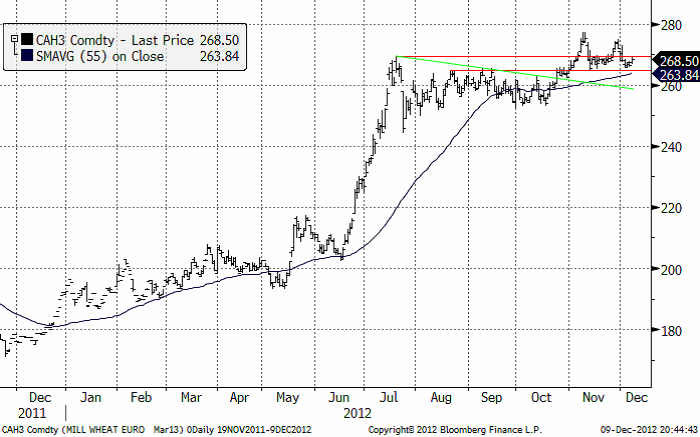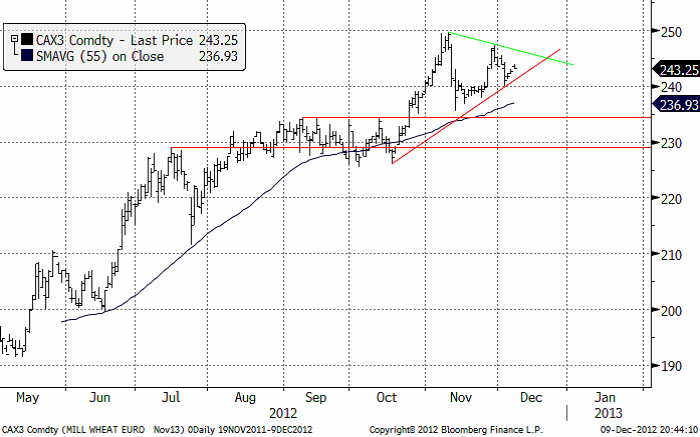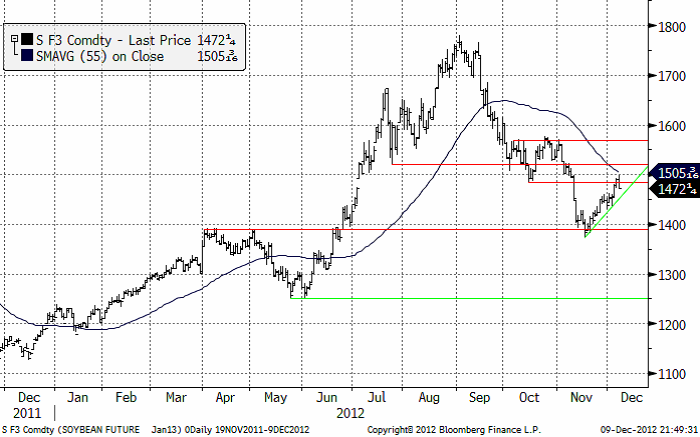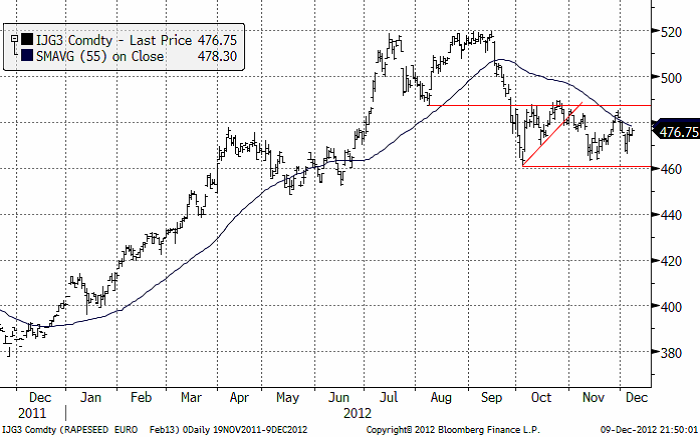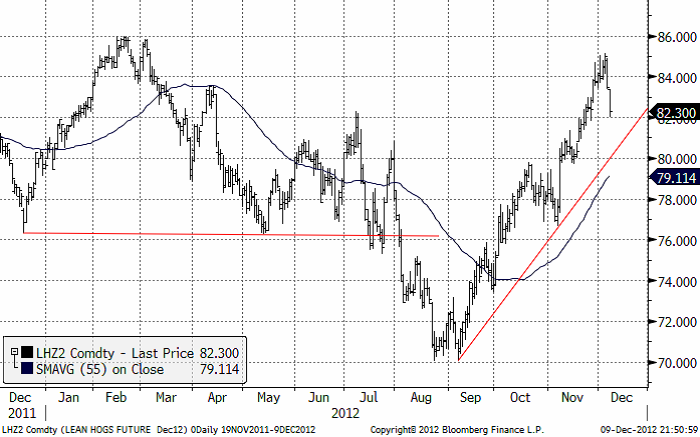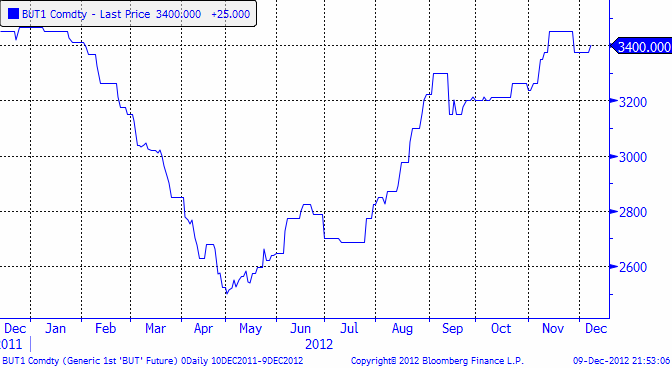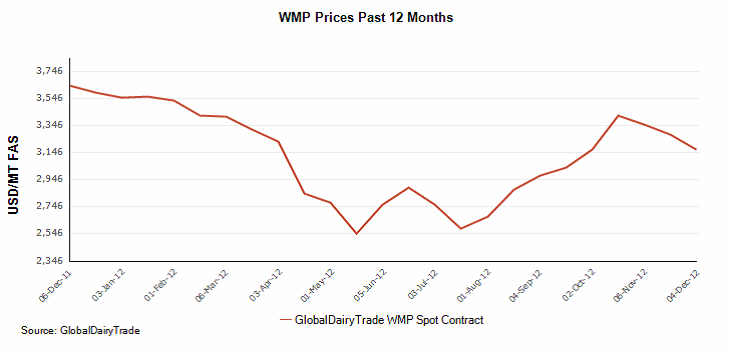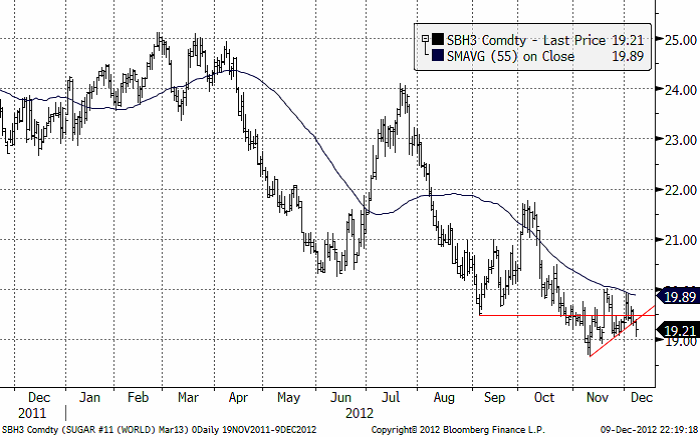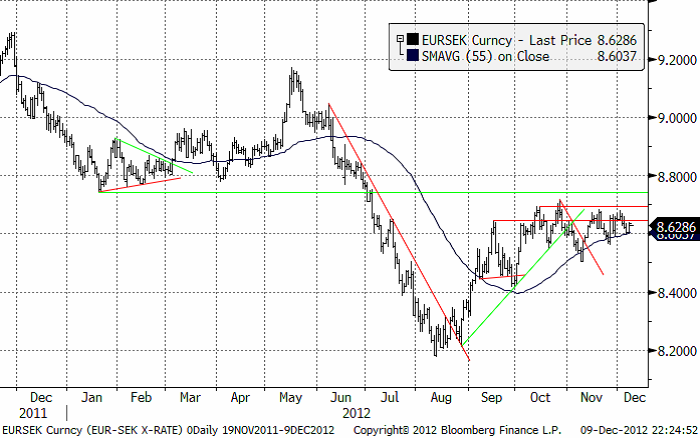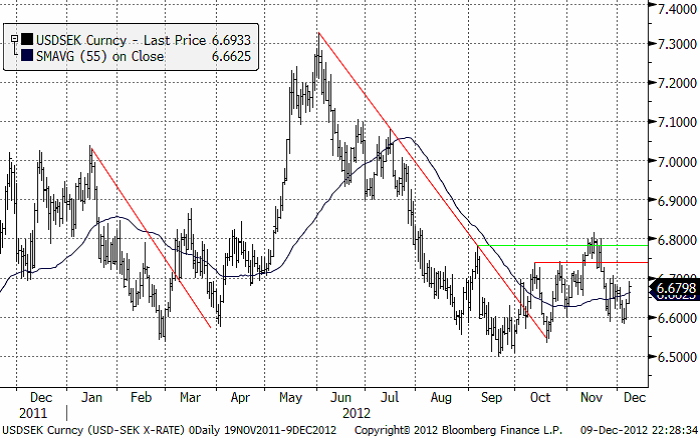Analys
SEB Jordbruksprodukter, 10 december 2012
 Veteterminerna oavsett löptid och sida av Atlanten har inte rört sig ens en procent i veckan som gick. Majsen är ett par procent billigare och sojan är ett par procent dyrare. Rapspriset förändrades dock inte. SMP fortsätter att sjunka och smöret att bli dyrare, vilket innebär att kombinationen av dem (mjölk) är oförändrat sedan förra veckan. Klass III mjölk i USA har dock fortsatt att falla i pris. SEB fortsätter, att som första bank i världen, erbjuda sina kunder att prissäkra ett börsbaserat mjölkpris i kronor per kilo, i poster om 10,000 kg.
Veteterminerna oavsett löptid och sida av Atlanten har inte rört sig ens en procent i veckan som gick. Majsen är ett par procent billigare och sojan är ett par procent dyrare. Rapspriset förändrades dock inte. SMP fortsätter att sjunka och smöret att bli dyrare, vilket innebär att kombinationen av dem (mjölk) är oförändrat sedan förra veckan. Klass III mjölk i USA har dock fortsatt att falla i pris. SEB fortsätter, att som första bank i världen, erbjuda sina kunder att prissäkra ett börsbaserat mjölkpris i kronor per kilo, i poster om 10,000 kg.
 Vi förnyar vår säljrekommendation på sojabönor. Marknadsutvecklingen ser riktigt svag ut.
Vi förnyar vår säljrekommendation på sojabönor. Marknadsutvecklingen ser riktigt svag ut.
Odlingsväder
Det fortsätter att vara torrt i USA och det påverkar inte bara de allt lägre förväntningarna på höstvetet inför våren, utan också möjligheten att transportera bort skördat vete och majs. Norra delarna av Mississippi-floden är inte längre farbar pga för lågt vattenstånd. Det rapporteras att silos är nästan fulla och att lantbrukarna får lov att skeppa majs via tåg till Texas, vilket är väldigt dyrt. Detta innebär att USA kan få svårt att exportera under vintern i den takt som varit vanligt. Det innebär också att lagerhyrorna stiger, vilket allt annat lika bör öka contangot i terminsmarknaderna för majs och vete framförallt i USA.
Den andra väderavvikelsen är det myckna regnandet i norra Argentina, som gjort att det har varit omöjligt på sina håll att så.
FAO
FAO’s senaste prognos över den globala spannmålsproduktionen under 2012 har reviderats ner marginellt med 2 mt till 2,282 mt sedan förra månadens rapport. Revideringen beror främst på justeringar av den beräknade produktionen av majs i Ryssland och Ukraina, efter att skördarna där nu går mot sitt slut, samt minskad produktion av vete i Australien och Brasilien där skörden nu pågår. Tidiga indikationer för höstvetet, som nu har såtts på det norra halvklotet, är blandade och något mindre lovande än för en månad sedan. Den senaste informationen tyder på att lantbrukare i allmänhet har ökat sådden av höstvete i respons till höga priser. Väderförhållandena är dock fortfarande negativa, med torka i delar av USA och Ryssland, medan stora producerande delar av EU har haft alltför mycket väta som har hindrat fältarbete.
Vete
Nedan ser vi kursdiagrammet för marskontraktet på Matif. Priset har fortsatt sidledes under veckan. Det är inte någon vidare styrka i marknaden. Om priset inte vill gå upp, kanske det snart är dags att testa nedsidan.
Nedan ser vi kursdiagrammet för kommande skörd, november 2013. Vi ser att den senaste toppen i slutet av november var lägre än den i början av november. Vi ser också stigande toppar. Det är alltså en så kallad ”triangelformation”, från textboken. Dessa uppträder ibland vid viktiga trendvändningar. Vi får hålla ett öga på vad som händer, i synnerhet om stödlinjen skulle brytas, vilket sker om kursen på kontraktet faller ner mot 240 euro igen. Det kan då innebära att trenden har vänt ner. Än så länge är dock trenden uppåtriktad, men vi skulle inte ta nya färska positioner för ytterligare en uppgång.
Den senaste GASC-tendern blev klar i veckan som gick. Den visade att franskt och amerikanskt vete tog hem det mesta. Rumänskt vete var med för leverans i närtid, men inte mot slutet av perioden. Ryskt och Ukrainskt vete var inte med alls, det kom inga erbjudanden alls. Det visar att dessa, som vi skrivit om tidigare, har nått sitt de facto ”exportstopp”. USA kan, pga stoppet i exportkanalen Mississippi-floden försvinna från världsmarknaden eller i vart fall minska. Ur detta perspektiv kan man inte utesluta ytterligare en pristopp i spotkontraktet under våren, alltså marskontrakten i Chicago och Paris.
Torkan i USA är så stor att man räknar med att upp mot 35% av HRWW-fälten kommer att överges och besås med annat. Det innebär att premien för högproteinvete troligtvis kommer att gå upp. De lantbrukare i Sverige som kommer att ”tvingas” så vårvete kan behöver därför troligtvis inte oroa sig för ett lågt pris vid skörd.
Maltkorn
November 2013-kontraktet har fallit i pris med ett par procent. Marknaden har tappat mycket momentum sedan uppgången i somras.
Potatis
Potatispriset för leverans i april har fortsatt att pendla kring 30 euro per dt. Vi ser kursutvecklingen i diagrammet nedan. För leverans i april 2014, dvs av den kommande sommarens skörd, föll priset från 16 till 15.80 euro per dt. Hela prisfallet skedde i fredags. Under fredagen var priset nere på 15.50 euro, innan marknaden återhämtade sig till stängning på 15.80.
Majs
Majspriset (mars 2013) slutade veckan med ett ordentligt prisfall och stängde nära dagslägsta. Det ser ut som om fallet kan fortsätta ner mot det tekniska stödet på strax över 700 cent och testa det. Ett brott av det på nedsidan skulle signalera en större prisnedgång.
Etanolproduktionen i USA var något högre än väntat, däremot rapporterade DOE lagerstatstik som var högre än väntat. Om USA når ”the fiscal cliff” är stödet för etanolinblandning i fara. USA kan också ta till en sänkning av inblandningen för att undvika att ”the fiscal cliff” ska slå till. Marknaden har också slagits av att exporten från Sydamerika är så stark, samtidigt som USA har stora exportproblem med Mississippifloden som redan är stängd för vintern vid de norra delarna, från St Louis och norrut.
Sojabönor
Sojabönorna har stigit i pris de senaste veckorna, men vi anser inte att detta är en stigande trend, utan en normal rekyl i en fallande marknad. Stödlinjen ligger strax under dagens kurs och vi tror att den kommer att brytas i veckan. Vi har därför en säljrekommendation alltjämt, men något mer aktualiserad i det här veckobrevet. Priset har gått upp till en nivå där man kunde vänta sig motstånd och slutet på rekylen. Nu väntar troligen ett nytt test på nedsidan av 1400-nivån.
Som vi nämnt ovan, är norra Argentina blött. Stora delar av delstaten Buenos Aires är drabbat av översvämningar. Sådden är var avklarad till 54% i veckan. Det talas om att lantbrukare byter från majs till sojabönor i ganska stor utsträckning, vilket gör det svårt att följa statistiken. Väderleksprognosen ser bra ut för Argentina i veckan som kommer, med huvudsakligen torrt väder.
Raps
Rapspriset (februari 2013) är oförändrat jämfört med förra veckan. Marknaden handlar i ett brett intervall, liksom sojabönorna. Däremot hann inte marknaden påverkas av prisfallet på soja i USA i fredags, då Matif redan hade stängt då.
StatsCanadas senaste uppdatering av skördeestimatet kom in lägre än förväntat, på 13.3 mt. USDA hade senast ett estimat för Kanada på 13.4 mt. Men vid den sista juni har då Kanada bara 5 dagars konsumtion kvar i lager, vilket är osannolikt för lågt. Den här verkligheten talar för ett högt pris framöver, men det ser inte så ut tekniskt.
Gris
Grispriset (Dec 12) har fallit kraftigt i två dagar, efter att uppgången förmodligen nått sin topp i den uppgång som varat sedan augusti. Trenden uppåt är dock inte bruten än, men de två senaste dagarnas kraftiga kursfall stämmer inte med en marknad i uppgång. Prisfallet är för stort för det.
Mjölk
Från EUREX priser på smör och SMP kan vi utläsa att priset för ett kilo mjölk (råvara) nu ligger på 3.51 kr per kilo. Priset på mjölkpulver i Nordeuropa har fortsatt att utveckla sig svagt.
Nedan ser vi priset på smör, som är lite starkare än marknaden för pulver.
Det börsbaserade priset i svenska kronor beräknas med formeln:
där
BUT = priset på smör i euro per ton
SMP = priset på skummjölkspulver i euro per ton
FX = växelkursen för EURSEK.
Precis som vi skrev i förra veckans brev så fann priset på Klass 3 mjölk, på den amerikanska börsen CME i Chicago, tekniskt stöd på 19 cent per pund och rekylerade uppåt därifrån. Trenden är dock nedåtriktad och en rekyl uppåt tycker vi ska ses som ett säljtillfälle.
Precis som vi skrivit de senaste veckorna, har priset på klass 3 mjölk fallit ordentligt.
Enligt Nya Zeelands Fonterra Cooperative Group Ltd föll priset på helmjölkspulver till den lägsta nivån på två månader. Februarikontraktet för helmjölkspulver noterade en nedgång på 3.2 % till 3,157 usd/mt.
Socker
Priset på socker (mars 2013) har misslyckats med att ta sig över motståndet på 20 cent. Istället bröts stödlinjen vid 19.40 cent i fredags. Det signalerar ett nytt test av 19 cent och kanske även 18.69, som är kontraktslägsta.
Gödsel
Spotkontraktet för Urea FOB Yuzhnyy som fann en stödnivå på 365 $ / ton i början av mnovember, har fortsatt att successivt stiga. Prisrörelsen ligger fortfarande inom det intervall som urea handlats till sedan juni. Det fortsätter alltså att vara stabila priser och det finns just nu inga tecken på att det ska förändras.
EURSEK
EURSEK har inte orkat ta sig över 8.70 kr, utan istället stött på ganska hårt motstånd där. Kampen mellan köpare och säljare av euro mot kronor kämpar om övertaget. Ett brott på uppsidan av 8.70 skulle innebära att säljarna vunnit för tillfället. Vi noterar dock att bottnarna stigit den högre månaden, utan att högre toppar noterats. Det kan betyda att ett brott på nedsidan rycker närmare.
USDSEK
Dollarna fortsätter att handlas ”sidledes”. 6.60 kr per dollar ser ut som ett stöd. Kursen har vänt upp från den nivån två gånger sedan månadsskiftet oktober/november. 6.70 ser likaledes ut som en motståndsnivå. Vid 6.80 ser vi ytterligare en motståndsnivå. Just nu ser det ut som om vi kan förvänta oss ännu mer ”sidledes” rörelse inom detta intervall.
[box]SEB Veckobrev Jordbruksprodukter är producerat av SEB Merchant Banking och publiceras i samarbete och med tillstånd på Råvarumarknaden.se[/box]
Disclaimer
The information in this document has been compiled by SEB Merchant Banking, a division within Skandinaviska Enskilda Banken AB (publ) (“SEB”).
Opinions contained in this report represent the bank’s present opinion only and are subject to change without notice. All information contained in this report has been compiled in good faith from sources believed to be reliable. However, no representation or warranty, expressed or implied, is made with respect to the completeness or accuracy of its contents and the information is not to be relied upon as authoritative. Anyone considering taking actions based upon the content of this document is urged to base his or her investment decisions upon such investigations as he or she deems necessary. This document is being provided as information only, and no specific actions are being solicited as a result of it; to the extent permitted by law, no liability whatsoever is accepted for any direct or consequential loss arising from use of this document or its contents.
About SEB
SEB is a public company incorporated in Stockholm, Sweden, with limited liability. It is a participant at major Nordic and other European Regulated Markets and Multilateral Trading Facilities (as well as some non-European equivalent markets) for trading in financial instruments, such as markets operated by NASDAQ OMX, NYSE Euronext, London Stock Exchange, Deutsche Börse, Swiss Exchanges, Turquoise and Chi-X. SEB is authorized and regulated by Finansinspektionen in Sweden; it is authorized and subject to limited regulation by the Financial Services Authority for the conduct of designated investment business in the UK, and is subject to the provisions of relevant regulators in all other jurisdictions where SEB conducts operations. SEB Merchant Banking. All rights reserved.
Analys
Brent crude ticks higher on tension, but market structure stays soft

Brent crude has climbed roughly USD 1.5-2 per barrel since Friday, yet falling USD 0.3 per barrel this mornig and currently trading near USD 67.25/bbl after yesterday’s climb. While the rally reflects short-term geopolitical tension, price action has been choppy, and crude remains locked in a broader range – caught between supply-side pressure and spot resilience.

Prices have been supported by renewed Ukrainian drone strikes targeting Russian infrastructure. Over the weekend, falling debris triggered a fire at the 20mtpa Kirishi refinery, following last week’s attack on the key Primorsk terminal.
Argus estimates that these attacks have halted ish 300 kbl/d of Russian refining capacity in August and September. While the market impact is limited for now, the action signals Kyiv’s growing willingness to disrupt oil flows – supporting a soft geopolitical floor under prices.
The political environment is shifting: the EU is reportedly considering sanctions on Indian and Chinese firms facilitating Russian crude flows, while the U.S. has so far held back – despite Bessent warning that any action from Washington depends on broader European participation. Senator Graham has also publicly criticized NATO members like Slovakia and Hungary for continuing Russian oil imports.
It’s worth noting that China and India remain the two largest buyers of Russian barrels since the invasion of Ukraine. While New Delhi has been hit with 50% secondary tariffs, Beijing has been spared so far.
Still, the broader supply/demand balance leans bearish. Futures markets reflect this: Brent’s prompt spread (gauge of near-term tightness) has narrowed to the current USD 0.42/bl, down from USD 0.96/bl two months ago, pointing to weakening backwardation.
This aligns with expectations for a record surplus in 2026, largely driven by the faster-than-anticipated return of OPEC+ barrels to market. OPEC+ is gathering in Vienna this week to begin revising member production capacity estimates – setting the stage for new output baselines from 2027. The group aims to agree on how to define “maximum sustainable capacity,” with a proposal expected by year-end.
While the IEA pegs OPEC+ capacity at 47.9 million barrels per day, actual output in August was only 42.4 million barrels per day. Disagreements over data and quota fairness (especially from Iraq and Nigeria) have already delayed this process. Angola even quit the group last year after being assigned a lower target than expected. It also remains unclear whether Russia and Iraq can regain earlier output levels due to infrastructure constraints.
Also, macro remains another key driver this week. A 25bp Fed rate cut is widely expected tomorrow (Wednesday), and commodities in general could benefit a potential cut.
Summing up: Brent crude continues to drift sideways, finding near-term support from geopolitics and refining strength. But with surplus building and market structure softening, the upside may remain capped.
Analys
Volatile but going nowhere. Brent crude circles USD 66 as market weighs surplus vs risk

Brent crude is essentially flat on the week, but after a volatile ride. Prices started Monday near USD 65.5/bl, climbed steadily to a mid-week high of USD 67.8/bl on Wednesday evening, before falling sharply – losing about USD 2/bl during Thursday’s session.

Brent is currently trading around USD 65.8/bl, right back where it began. The volatility reflects the market’s ongoing struggle to balance growing surplus risks against persistent geopolitical uncertainty and resilient refined product margins. Thursday’s slide snapped a three-day rally and came largely in response to a string of bearish signals, most notably from the IEA’s updated short-term outlook.
The IEA now projects record global oversupply in 2026, reinforcing concerns flagged earlier by the U.S. EIA, which already sees inventories building this quarter. The forecast comes just days after OPEC+ confirmed it will continue returning idle barrels to the market in October – albeit at a slower pace of +137,000 bl/d. While modest, the move underscores a steady push to reclaim market share and adds to supply-side pressure into year-end.
Thursday’s price drop also followed geopolitical incidences: Israeli airstrikes reportedly targeted Hamas leadership in Doha, while Russian drones crossed into Polish airspace – events that initially sent crude higher as traders covered short positions.
Yet, sentiment remains broadly cautious. Strong refining margins and low inventories at key pricing hubs like Europe continue to support the downside. Chinese stockpiling of discounted Russian barrels and tightness in refined product markets – especially diesel – are also lending support.
On the demand side, the IEA revised up its 2025 global demand growth forecast by 60,000 bl/d to 740,000 bl/d YoY, while leaving 2026 unchanged at 698,000 bl/d. Interestingly, the agency also signaled that its next long-term report could show global oil demand rising through 2050.
Meanwhile, OPEC offered a contrasting view in its latest Monthly Oil Market Report, maintaining expectations for a supply deficit both this year and next, even as its members raise output. The group kept its demand growth estimates for 2025 and 2026 unchanged at 1.29 million bl/d and 1.38 million bl/d, respectively.
We continue to watch whether the bearish supply outlook will outweigh geopolitical risk, and if Brent can continue to find support above USD 65/bl – a level increasingly seen as a soft floor for OPEC+ policy.
Analys
Waiting for the surplus while we worry about Israel and Qatar

Brent crude makes some gains as Israel’s attack on Hamas in Qatar rattles markets. Brent crude spiked to a high of USD 67.38/b yesterday as Israel made a strike on Hamas in Qatar. But it wasn’t able to hold on to that level and only closed up 0.6% in the end at USD 66.39/b. This morning it is starting on the up with a gain of 0.9% at USD 67/b. Still rattled by Israel’s attack on Hamas in Qatar yesterday. Brent is getting some help on the margin this morning with Asian equities higher and copper gaining half a percent. But the dark cloud of surplus ahead is nonetheless hanging over the market with Brent trading two dollar lower than last Tuesday.

Geopolitical risk premiums in oil rarely lasts long unless actual supply disruption kicks in. While Israel’s attack on Hamas in Qatar is shocking, the geopolitical risk lifting crude oil yesterday and this morning is unlikely to last very long as such geopolitical risk premiums usually do not last long unless real disruption kicks in.
US API data yesterday indicated a US crude and product stock build last week of 3.1 mb. The US API last evening released partial US oil inventory data indicating that US crude stocks rose 1.3 mb and middle distillates rose 1.5 mb while gasoline rose 0.3 mb. In total a bit more than 3 mb increase. US crude and product stocks usually rise around 1 mb per week this time of year. So US commercial crude and product stock rose 2 mb over the past week adjusted for the seasonal norm. Official and complete data are due today at 16:30.
A 2 mb/week seasonally adj. US stock build implies a 1 – 1.4 mb/d global surplus if it is persistent. Assume that if the global oil market is running a surplus then some 20% to 30% of that surplus ends up in US commercial inventories. A 2 mb seasonally adjusted inventory build equals 286 kb/d. Divide by 0.2 to 0.3 and we get an implied global surplus of 950 kb/d to 1430 kb/d. A 2 mb/week seasonally adjusted build in US oil inventories is close to noise unless it is a persistent pattern every week.
US IEA STEO oil report: Robust surplus ahead and Brent averaging USD 51/b in 2026. The US EIA yesterday released its monthly STEO oil report. It projected a large and persistent surplus ahead. It estimates a global surplus of 2.2 m/d from September to December this year. A 2.4 mb/d surplus in Q1-26 and an average surplus for 2026 of 1.6 mb/d resulting in an average Brent crude oil price of USD 51/b next year. And that includes an assumption where OPEC crude oil production only averages 27.8 mb/d in 2026 versus 27.0 mb/d in 2024 and 28.6 mb/d in August.
Brent will feel the bear-pressure once US/OECD stocks starts visible build. In the meanwhile the oil market sits waiting for this projected surplus to materialize in US and OECD inventories. Once they visibly starts to build on a consistent basis, then Brent crude will likely quickly lose altitude. And unless some unforeseen supply disruption kicks in, it is bound to happen.
US IEA STEO September report. In total not much different than it was in January
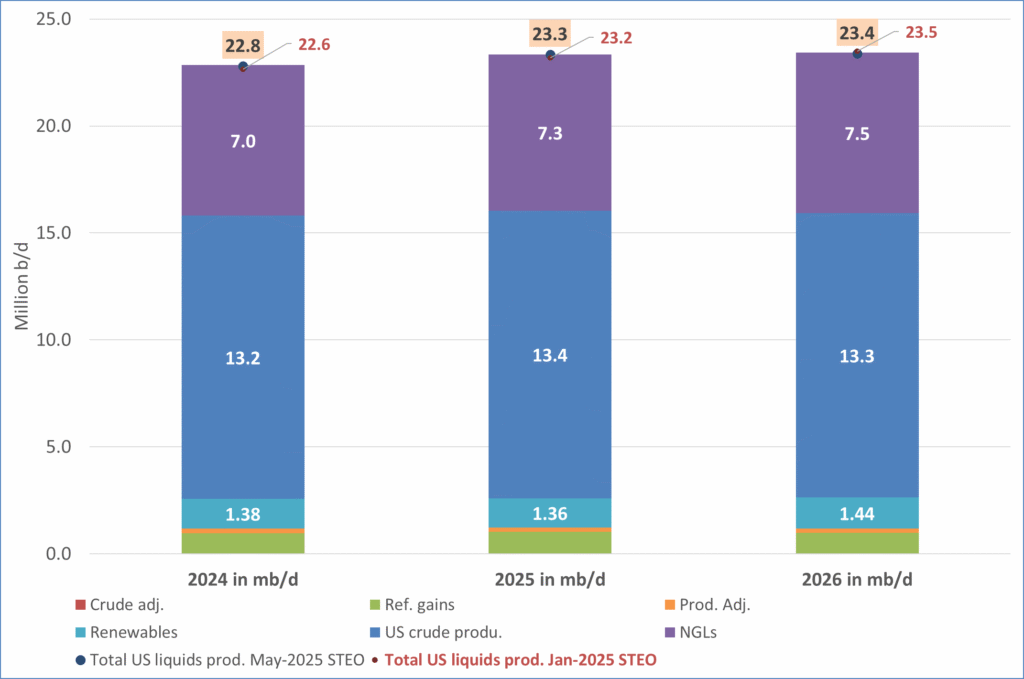
US IEA STEO September report. US crude oil production contracting in 2026, but NGLs still growing. Close to zero net liquids growth in total.
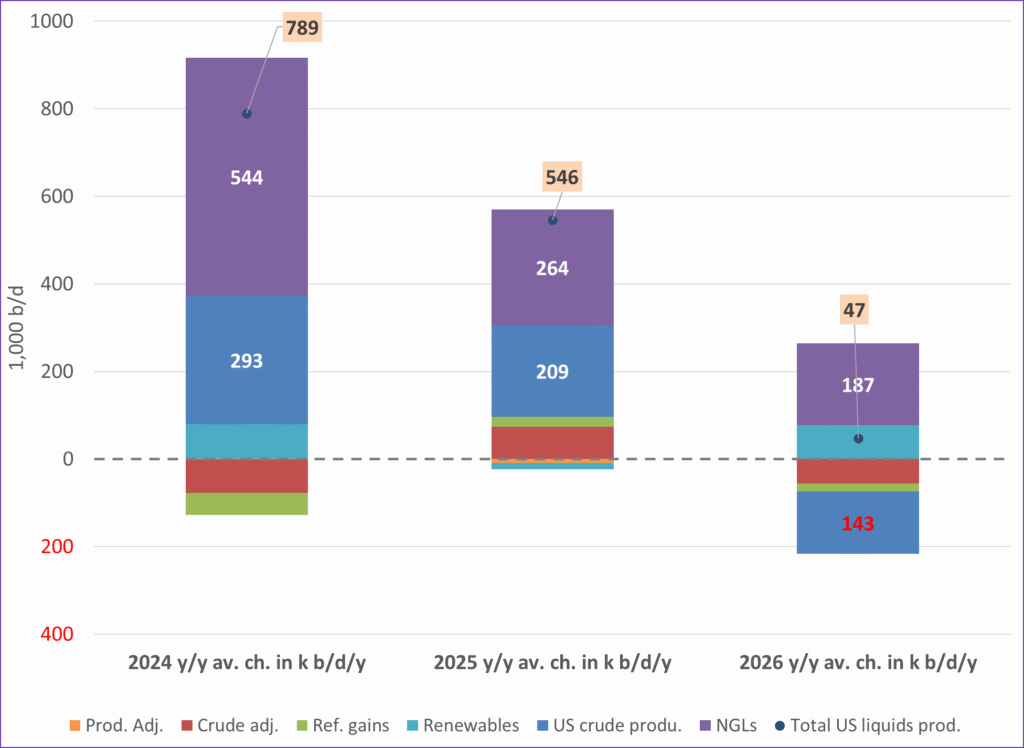
-

 Nyheter4 veckor sedan
Nyheter4 veckor sedanMeta bygger ett AI-datacenter på 5 GW och 2,25 GW gaskraftverk
-
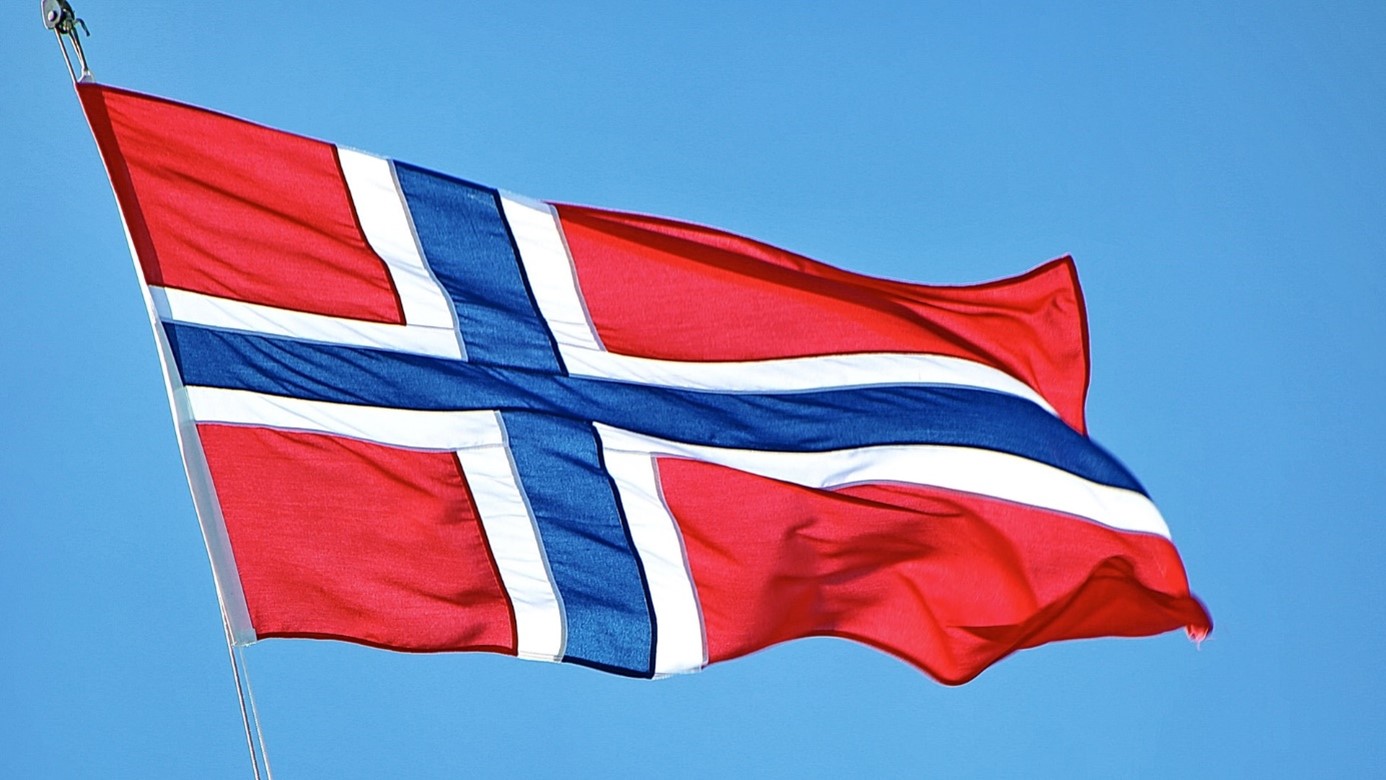
 Nyheter4 veckor sedan
Nyheter4 veckor sedanAker BP gör ett av Norges största oljefynd på ett decennium, stärker resurserna i Yggdrasilområdet
-

 Nyheter4 veckor sedan
Nyheter4 veckor sedanSommarens torka kan ge högre elpriser i höst
-

 Analys4 veckor sedan
Analys4 veckor sedanBrent edges higher as India–Russia oil trade draws U.S. ire and Powell takes the stage at Jackson Hole
-

 Nyheter3 veckor sedan
Nyheter3 veckor sedanMahvie Minerals är verksamt i guldrikt område i Finland
-

 Analys3 veckor sedan
Analys3 veckor sedanIncreasing risk that OPEC+ will unwind the last 1.65 mb/d of cuts when they meet on 7 September
-
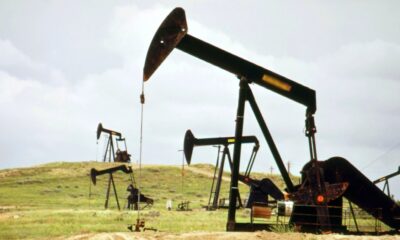
 Nyheter3 veckor sedan
Nyheter3 veckor sedanNeil Atkinson spår att priset på olja kommer att stiga till 70 USD
-

 Analys2 veckor sedan
Analys2 veckor sedanOPEC+ in a process of retaking market share


